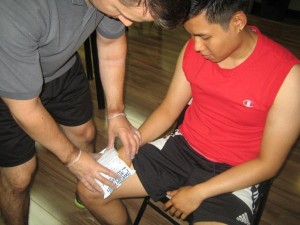Immortalized in one of Shakespeare’s classic novels, Julius Caesar is 
A stab wound is a kind of penetrating trauma made by a thrust to the skin, usually in a form of knife. Nonetheless, other objects which are usually sharp and with pointed ends are also used. These objects are usually deeper than it is wide. Stab wounds result to different external and internal injuries. Rather than causing damage to adjacent tissue, injuries of this cause are brought about to the path the weapon took internally. The most common site for stab wounds is the abdomen, where many internal organs are located.
Stab wounds are often painful and prove to be fatal especially if they struck vital organs. These kinds of wounds need emergency medical assistance as soon as possible. However, while waiting for the paramedics to arrive, first aid may be administered to the bleeding victim to help alleviate pain and bleeding. St Mark James programs offer First Aid training which comprise of teaching their trainees how to give proper treatment of major wounds such as stab wounds.
Before giving help, assess the situation. Usually, stabbing occurs out of violence and the attackers may still be in the vicinity. It is important to not put one’s self in danger in order to not add to the number of victims. If possible, wear gloves to minimize the risk for infection. If none is available, wash hands and make sure they are extremely clean. Try to reduce contact with the victim’s blood.
Check the victim’s airway. If there is blood in the mouth, slowly assist them to their side. Gently remove the victim’s clothing to help identify the exact location of the stab wound. If the object used for stabbing is still stuck in the skin, do not remove it. Removing will increase blood loss and pushing the object in will increase damage. Dress the wound around the stabbing object with sterile cloth. Press around the wound. However, if the object has been dislodged, apply direct pressure on the wound using any absorbent material, preferably a clean dressing. Applying pressure on the wound helps lower the rate of bleeding. If major bleeding persists, apply pressure to the major artery leading to the area of the wound with the pads of the rescuer’s fingers, pushing down to the bone. If bleeding still continues, a tourniquet may be applied. To cover the dressing, a bandage or tape may be used. Do not remove the dressing to avoid the wound from bleeding again. If the dressing becomes soaked in blood, simply add more cloth above the old dressing.
In cases of chest wounds, the wound should be covered with a plastic bag, or kitchen foil, covering only three sides of the wound. This is done to allow air to escape from one side of the bandage and avoid entrance to the pleural cavity. If the stab wound is in the limbs, position the victim where the wound is above heart level to decrease blood loss. Continuously apply pressure on the wound and check or circulation, airway and breathing until paramedic arrives. If the victim loses consciousness, place the victim in the recovery position. If no breathing and pulse is detected, initiate CPR.
CPR has specific techniques that are taught in CPR classes. Early CPR saves lives. St Mark James programs also offer a variety of practical lessons in CPR and basic life support that are applicable to many different emergency situations.
